The only way to reach the mystic emerald valleys of Santo Antão is to board a ferry from the neighboring island of São Vicente. A sleepy Shangri-la with a dreamlike charm, the magic of Cabo Verde’s westernmost island stirs to life long before the ships even catch sight of the shore.
As the waves broke into white pearls over a canvas of deep sapphire blue, we kept our eyes fixed over the water. One by one, flying fish leapt from the fathoms and soared through the air with tapered wings, gliding over the surface like silver hummingbirds before disappearing back into the ocean foam. It was early February, and there on the outer rim of West Africa, the skies and seas knew no winter. We were enraptured by glorious warmth. On the bow of our boat, under the light of champagne rays, we basked away the hour-long chug from the piers of Mindelo to Porto Novo, every second billowing blissfully further from the chaos on the continents.
Day 1
Arrival and “aluguer” to Pombas
It was a clamorous morning at Porto Novo. The docks were a market and we were now the fish. Shouts of “Ponta do Sol!” and “Ribeira Grande?” filled the air as each driver flung his destination as far as his voice could carry. We soon found ourselves herded, divided, and packed neatly like lost bubble-eyed sardines into one of the collective minivans lapping around the islands. Out of all the aluguers, ours was the emptiest, for we were headed neither to Ponta do Sol nor to Ribeira Grande, but somewhere smaller: Paul.

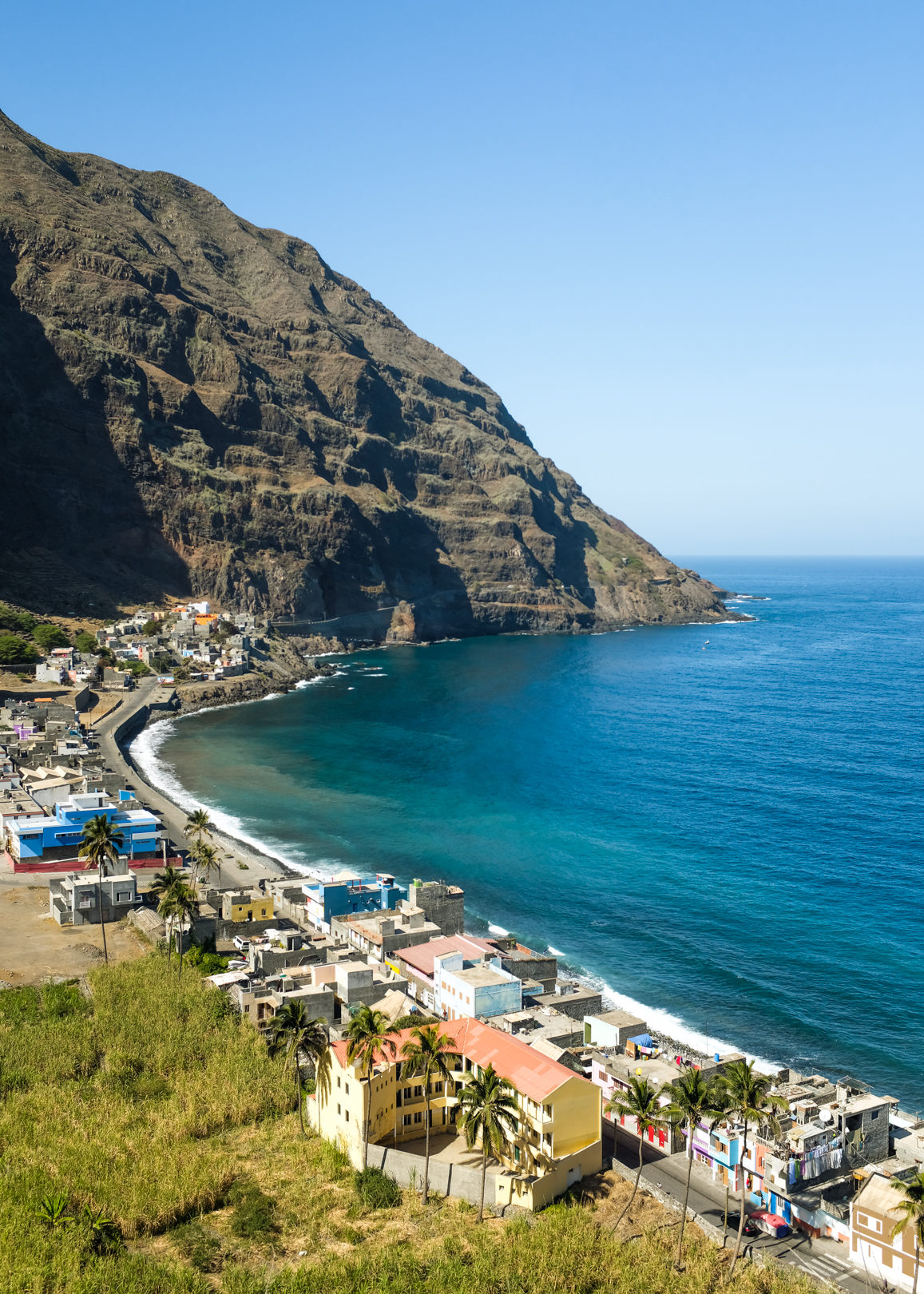
We were midway into our stay on Santo Antão when we learned that our village was named not after Paul the saint, but Paúl after the Latin palude, meaning “swamp.” As a matter of fact the village wasn’t called Paúl at all; that was the name of the valley. We were staying in Vila das Pombas. Translated from Portuguese, it meant “Village of Pigeons.”
A charming settlement with a seaside attitude, Pigeons was bisected by a stream. On one side, a steep series of steps led above a large magenta spill of bougainvilleas to the foot of a towering statue of Saint Anthony, in whose name Santo Antão was consecrated. On the other side, a paved pathway shaded by long-eared banana leaves and crowns of palm slowly wound into the navel of the valley.
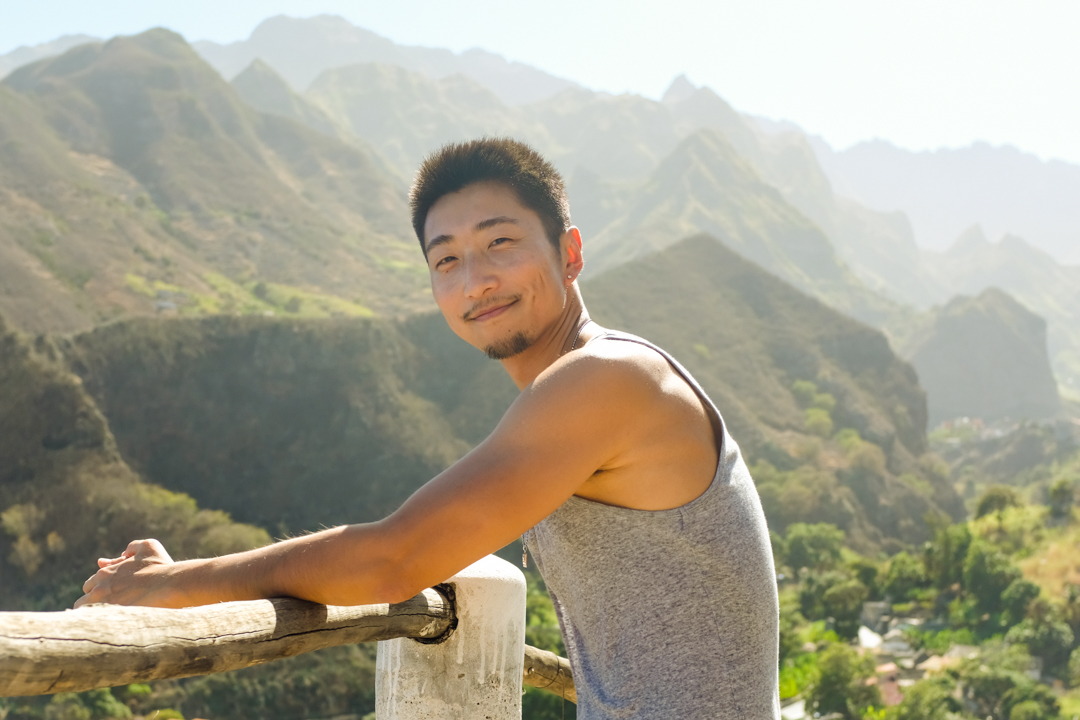

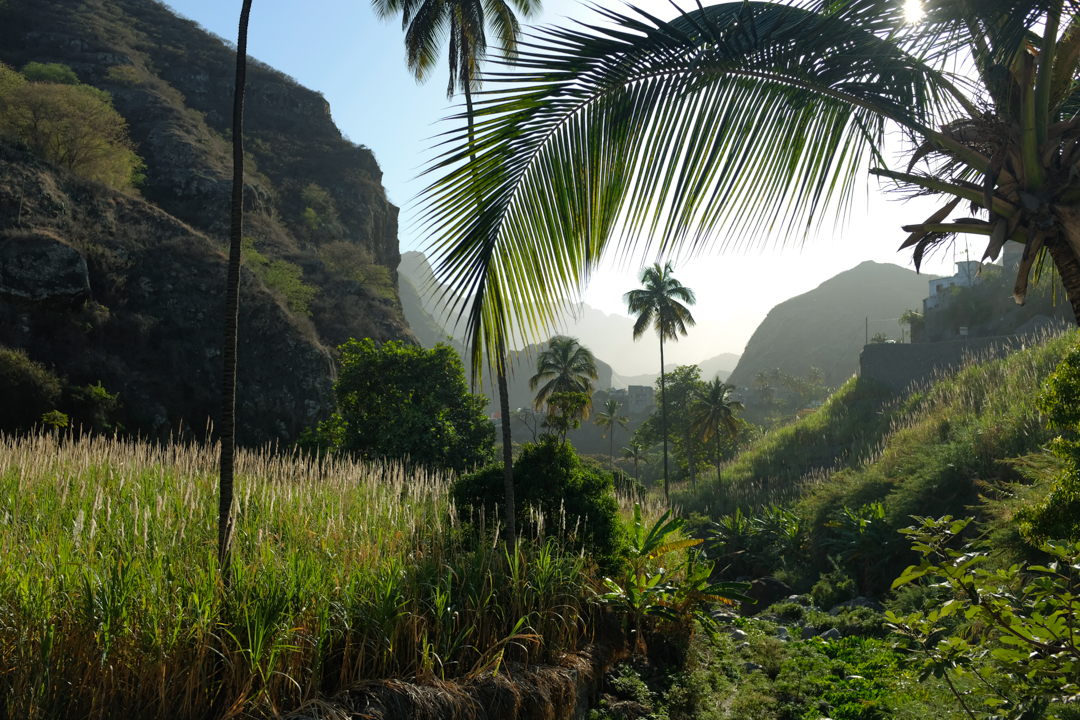
We followed the brick road awhile. Every curve revealed a frame more sublime than the next. In the approaching twilight, the towering shoots with their oblong papayas and layers upon layers of pleated viridescent ridges transformed the Vale do Paúl into a surreal surrounding, more akin to a fanciful flight of the imagination than to the tethers of reality.
Seeing several locals seated outside and finishing a meal, we followed suit. With a simple “bo tard” and not another question, we were brought our utensils and served a casserole filled to the brim with cachupa, Cabo Verde’s national dish. The hearty ambrosia of beans, hominy, and strips of meat tasted slow-cooked and glutinously gratifying. We ate our fill and drank in the last drops of sunlight trickling down into the valley.

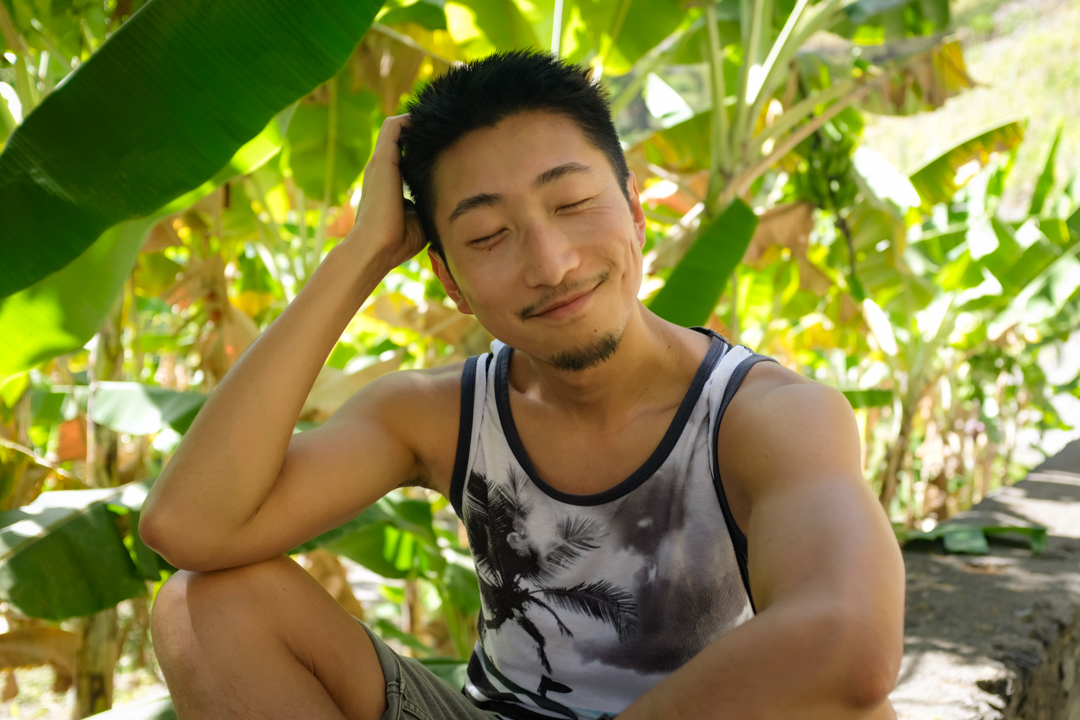


Day 2
Through the lush Vale do Paúl
The goal was never to hike up to Cova, Santo Antão’s crater overlooking the Vale do Paúl. I couldn’t see us walking for six straight hours, never mind doubling back for a descent. We agreed to go as far as we were inclined and to discover the valley without mission or haste.
It was a setting well-suited for us slow travelers, with a paved road that threaded through jagged fertile peaks and idyllic scenes of rural life. In the village of Eito, while trying to identify a cluster of bulbous fruits, António approached us and explained that the starch-rich fruta pão, or breadfruit, were rarely eaten raw but delicious when deep-fried. He pointed us to the mango trees that lined the walls of his house, and then to his workshop, jammed with metal vats used to distill sugarcane juice into molasses and grogue, the Cabo Verdeans’ take on rum.




Past the village of Lombinho, stalks of saccharine canes fell under the beating sun. Elderly women donning vibrant headscarves balanced baskets adroitly on top of their heads as they chattered and crossed our paths. Young boys tugged bucket drums half their size on the way to practice for their annual contribution to the Carnival festivities taking the island in a rising tempest.
The cobbled track came to a stop shortly after Cabo da Ribeira, signaling the start of an arduous last climb up to the Cova. A pair of women stood near the beginning of the trail with a selection of local produce from the valley: doce de coco, a sugary confection of shredded coconut; coffee beans; dried papaya; and a satchel of guava were amongst the assortment. I loved the grainy texture and the candied pink of guava juice, but I had never seen the fruit before. I had always imagined them to be much larger. Taking one, the older of the two women demonstrated how to eat it, pressing on the soft, yellow-green ball until it split open to reveal its tender, fleshy interior.


From the vertiginous peaks, we took in the marvelous view of the Vale: a supple tapestry sequined with fertile terraces and block houses that rolled out all the way to Pombas, just visible between two mountain sheets. It had taken us upwards of seven hours and all our persistence, but we finally stepped onto the edge of the Cova, where we were met by a surprise. In lieu of a dry and jagged volcanic crater, we stared down at a cultivated caldera of golden fields. The tiny settlement, Pico da Cruz, marked our terminus. The afternoon air was amber and sweet, laced with the scent of lemon and tarragon. We sniffed around and traced the source to the shrubs of wild marigold sprouting from the rocks.


Orlanda, “the only one in all of Paúl,” greeted us on our way back from the crater. When asked about the long walk through the valley, she let out a burst and proudly stated that she traverses the route daily.
“Look at me, how old?” She prodded us to make a guess, overflowing with a sass and energy that transcended linguistic barriers. “Cinquenta!” Celebrating her fiftieth year the following day, the spritely woman spoke with the look of adoration and pride in her eyes: her sons were coming to visit. They had all left home and were now spread across Santo Antão and São Vicente, but a reunion was due. Beckoning in Kriolu, “Pedro, ben,” she pulled the family together for a sentiment of kindness and ease so Cabo Verdean it cannot be translated, only understood: a moment of morabeza.


“I can make you some cachupa,” said the waitress in English and French as she donned her apron. We had arrived back in the center of Cabo da Ribeira in a famished state and sat down at the first restaurant we saw. “Or, if you want to eat right away, I can heat up some rice with chicken and chouriço.” Within minutes, we found ourselves garnishing small mountains of rice with piquant piri piri and satiating our rapacious hunger with overflowing spoons. Sitting a while to enjoy the fading light, we were reminded of the trek back to Pombas which still lay ahead. Bracing ourselves for a long night stroll, we started on the same winding path through the villages that were now rapidly dimming, but were ultimately spared the entire way down with the luck of a passing aluguer.


Day 3
From Xôxô to Sinagoga
The phallic rock column and almost aquatic contours of Xôxô remain one of the most impressionable natural wonders of my recent memory. It was an otherworldly site. We were fish again, this time weaving upstream, through and around the kelp-green terrains of a cloistered valley. It was a cloudless morning, bright and hot. Fueling our bodies with tall glasses of calda, chilled sugarcane juice, we began our day’s walk on the gentle asphalt road from Xôxô to Ribeira Grande.
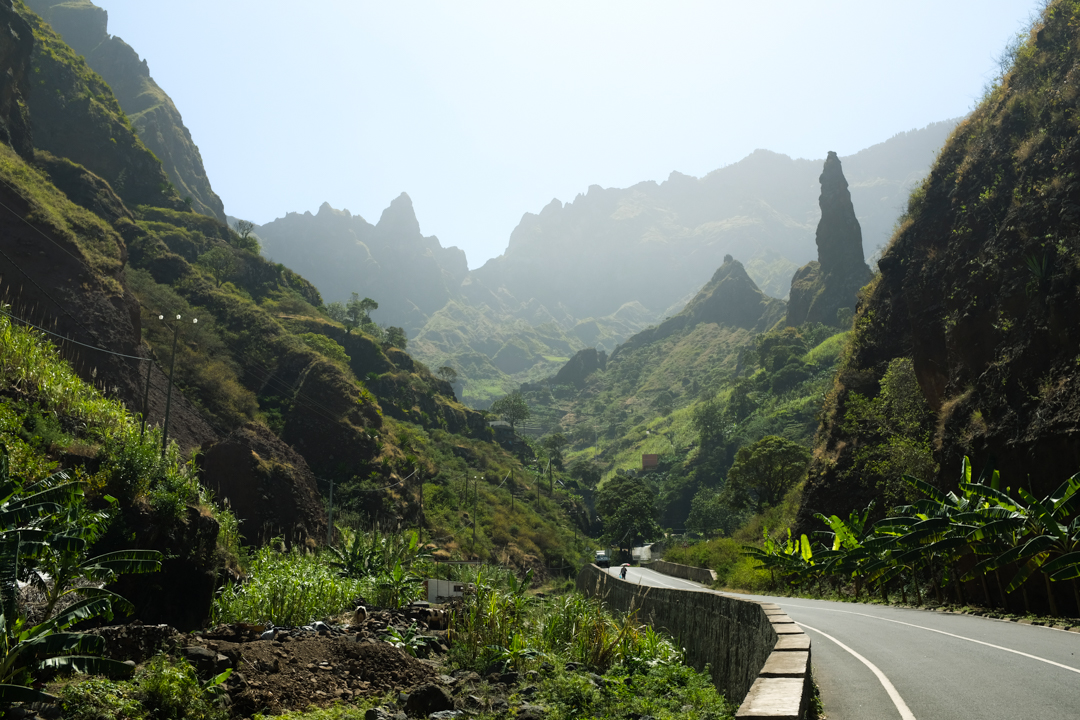
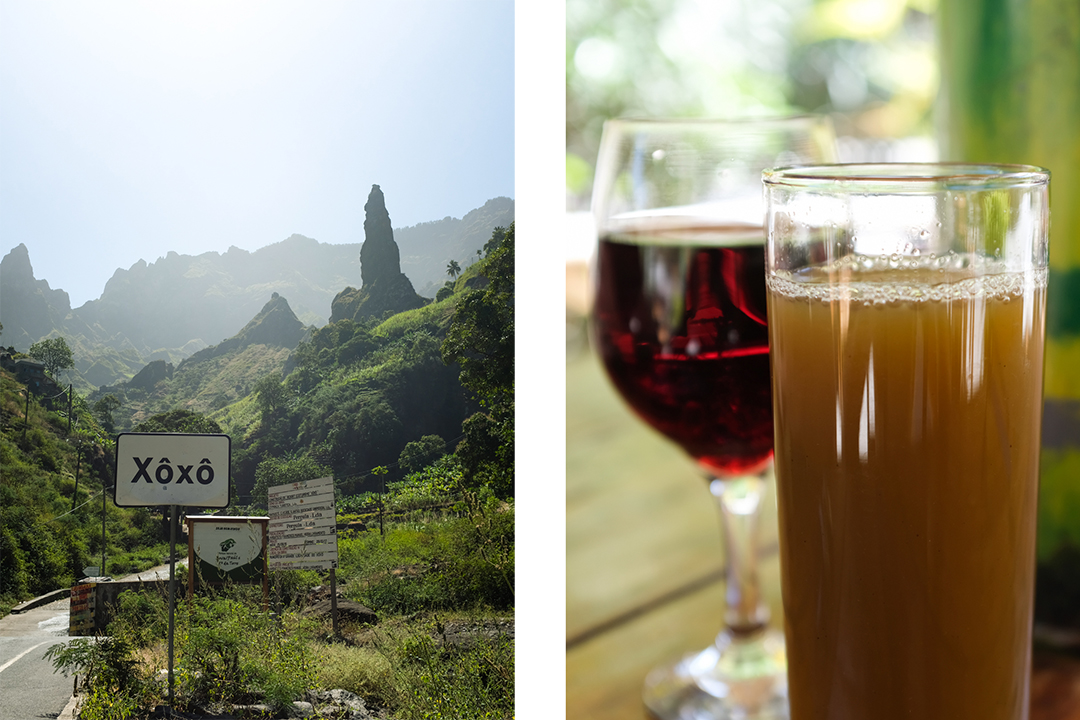

By the sea at Ribeira Grande, Santo Antão molted out of its quetzal pelage. Gone were the countless rows of tropical trees, the fresh verdure, the sensuous scapes of the valleys. In their place was a windswept, Martian coastline. We continued on the Atlantic road as little by little, the winds swept in shades of gray, umber, and steely blue.




The sun had all but disappeared at Sinagoga by the time we arrived, but we heard that the waters would still be warm. The former synagogue lay in ruins, but the village which had cropped up next to it was full of life and laughter.
“If you look at the locals around here, you’ll see a few with bright eyes and light, curly hair,” said Veronica as she slid into one of the natural rock pools giving off their last waves of heat. A New Yorker with Cabo Verdean roots, Veronica had recently returned to the islands to build a new home by the sea. Grounding herself under the saltwater and stretching into a yoga pose, she commenced with her thalassotherapy as she continued to speak.
“They’re the descendants of the Jews that used to live here.” Upon the end of the Portuguese Inquisition in the 19th century, Sephardic Jews from Morocco and Gibraltar began settling this small jewel of Cabo Verde, which was still a Portuguese colony at the time. But by the 20th century, most of them had left and made Aliyah to a newly founded State of Israel, leaving only traces of their presence in the irises and tresses of the people of Santo Antão. From Europe to Africa to the west of Asia, I pondered over the generational journeys and lives lived by these Sephardim. It was an unexpected filament of heritage on the verge of being forgotten.
We enjoyed our last moments in the water before the tide finally submerged the pools and the coarse waves sent us splashing towards the rocks. Sinagoga was closed for the day, but how could it not? Any moment as pure and perfect as this was too faultless to be anything more than an ephemeron.



How to get to Santo Antão
Ferries operated by CV Interilhas depart thrice daily from Mindelo on São Vicente to Porto Novo on Santo Antão. The journey takes approximately fifty minutes, with a one-way ticket costing 800 Cabo Verdean escudos or US $8.
Where to stay on Santo Antão
The Oasis Paúl is a calm retreat hidden right in the center of Vila das Pombas. Featuring down-to-earth hospitality, pristine rooms, and large balconies facing a quiet inner courtyard, it’s easy to pass the time here watching the songbirds as they hop, chirp, and scavenge for attention. Doubles around CVE 4,000 or US $40 per night.
Getting around Santo Antão
The most straightforward way to travel on Santo Antão is by aluguer, the islands’ shared taxis. Many aluguers drive fixed routes and will only depart when the driver deems that are enough passengers. They will stop at anywhere on their route and can be flagged down with a hitchhiking finger. Some visitors use aluguers as taxis or rent one for the entire day at a higher price. If taking an aluguer the usual way on Santo Antão, expect to pay around 100 escudos per person per ride.
